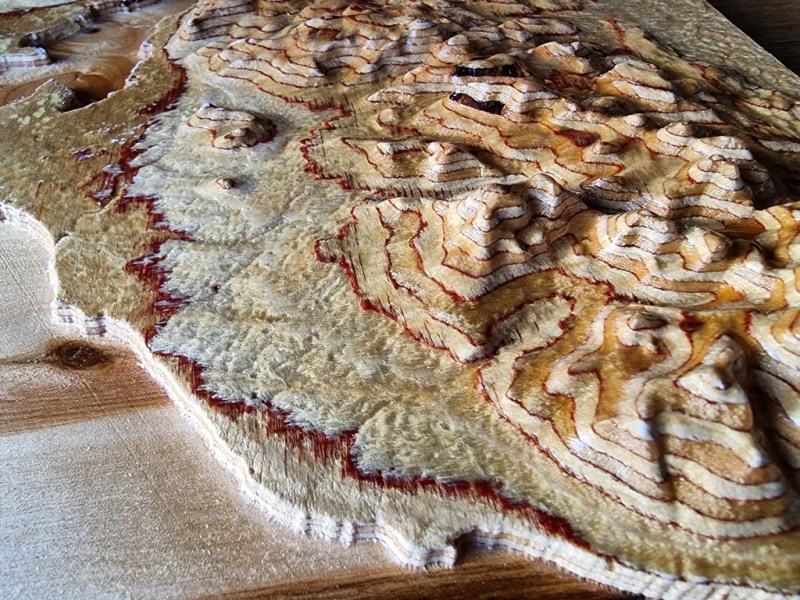CNC machines are incredibly versatile tools. At a machine shop, they can machine all kinds of metal and plastic parts. Beyond that, they can engrave various materials including glass, and even create PCBs. [Steve] has a CNC machine of his own creation in his shop, and while he might be employing it for those common uses, his artistic creations are on the showcase for today with these 3D topographic relief maps.
The key to creating a good topographic relief map is good material stock. [Steve] is working with plywood because the natural layering in the material mimics topographic lines very well, especially with the high-quality marine-grade birch plywood he is using. Making sure to select pieces without knots improves the final product substantially, as does taking the time to fill any voids. Selecting good stock is only part of the process though. [Steve] is using TouchTerrain, an open source project helmed by [Dr. Chris Harding] of Iowa State University, to create the model which gets fed to the CNC machine. Originally intended for 3D printing applications, the web-based tool lets you easily select an area on the globe and export its topographical data to a standard STL or OBJ file.
With good stock and the ability to easily create 3D topographic maps, anyone with a CNC machine like this could easily reproduce their terrain of choice. We imagine the process might be easily ported to other tools like 3D printers, provided the resolution is high enough. We have also seen similar builds using laser cutters, although the method used is a little different.
















Then make it a mould and pour cake layers into the mould and bake it. Everyone at the geology department would love you! The picture at least had me hungry for some topographical goodness :)
Confused myself, is it mold or mould? Or is that just American English? Also why is casting form the same word as the funghi? This irritates me every time.
Or is it moughld? A thorough examination of the language differences is beyond the scope here, so I ask: Have you had enough? We’re through then. English is weird.
I am amazed that there are people here that do not know that
there is English and
there is American.
And probably some more variants.
There is google translate if really required for you.
For example IRISH mold = ENGLISH mould as I just looked up for fun
This here is an international platform,
and there are possibly more non-English/Irish/American readers/posters here.
And we all can cope …
I thought there was UK English and American English.
And that “American” means “a person or thing of American origin (South AND/OR North)
Did it change recently or am I wrong ?
Officially, it’s not Uk/US, it’s the same as Chinese – traditional English and simplified English.
:P
I’d like to see Mexicans confuse people by saying they’re from the United States, which they are, the Estados Unidos de Mexico.
Spent 3 years of my childhood in Australia (I’m American). To this day, the slash system of dates, mm/dd/yy vs dd/mm/yy and UK/US spellings trip me up. I have to think about them EVERY TIME! I have decided it doesn’t matter. And I prefer YYYY-MM-DD.
Obligatory XKCD highlighting iso 8601
I heard recently that it wa Aluminum from the start and then it was changed to Aluminium. Something to do with grammatical renaissance among pedants.
XD Guess I’ll just call it alloy
Path is a little more complicated, it was made from Alum to start.
When there is a difference, the brits are wrong. Simple as that.
A) It’s spelled “fungi” in English.
B) They used to be two different words in Middle English.
Thanks for the etymological explanation what they were derived off! Interestingly enough the odd “cow dung” makes sense too, mold is not just soft but has a terrible vile smell too. Modulus i only know from engineering and physics.
But I feel bad for derailing as much with my written down thoughts. Sorry HaD!
Those two words had at least 10 acceptable spellings in middle English.
They had respect for creative spellers back then. Curse the inventor of dickonairys.
Let’s ban English altogether. From now on everyone is to speak Ashanti Akan language
It appears to be set for 3d printing by default.
Stunning work, I love how the glue lines add depth to it.
I 3d printed some of these a while back. I found the best detail was when you print them on the side (obvious reasons when you think about it). It is easier to get the detail in (what would normally be) the xy direction that way without needing a super tiny nozzle.
https://flic.kr/p/2mJfxYk
https://flic.kr/p/2mJ6XxE
Those 2 prints are about 100mm square.
Very nice
I have also now uploaded a YouTube version of my Terrai carving tutorial, https://youtu.be/QPqFPspLMyI.
And the Instructables version is here:https://www.instructables.com/Carving-3D-Terrain-Topographic-Relief-Maps-on-a-CN/